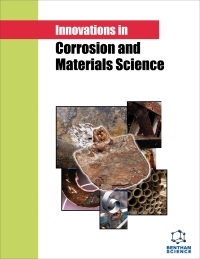- Home
- A-Z Publications
- Innovations in Corrosion and Materials Science (Discontinued)
- Previous Issues
- Volume 10, Issue 1, 2020
Innovations in Corrosion and Materials Science (Discontinued) - Volume 10, Issue 1, 2020
Volume 10, Issue 1, 2020
-
-
Stress Corrosion Cracking of Structural Nuclear Materials: Influencing Factors and Materials Selection
More LessAuthors: Renato A. Antunes and Mara C. L. de OliveiraStress Corrosion Cracking (SCC) plays a central role in the development of improved structural nuclear materials. Complex interactions between microstructure, alloy composition, manufacturing and environmental factors make the understanding of this phenomenon difficult. This work aimed at reviewing the scientific literature on the SCC behavior of structural nuclear materials in order to identify the main factors that govern Read More
-
-
-
Formation and Characterization of Dispersed Mixed Iron-titanium Oxide Systems by Electrochemical Method
More LessAims: Anodic polarization behavior of a combined iron-titanium electrode (two metals in electrical contact with each other) in aqueous solutions containing halide ions (F- and Cl-) was studied. Methods: The joint anodic dissolution of titanium and iron with subsequent thermal treatment makes it possible to obtain precursors of a highly dispersed mixed oxide system Fe2O3-TiO2. The phase and elemental composition and structu Read More
-
-
-
Influence of Biocompatible Coating on Titanium Surface Characteristics
More LessBackground: Nowadays investigations in the field of dental implants engineering are focused on bioactivity and osseointegration properties. Objective: In this study, the oxide-covered titanium was functionalized by vitamin D3 molecules via a simple self-assembly method with the aim to design more corrosion-resistant and at the same time more bioactive surface. Methods: Surface properties of the D3-coated titanium w Read More
-
-
-
Susceptibility to Localized Corrosion of ASTM F745 and UNS S32750 Stainless Steels Influence of pH and Cytotoxicity Evaluation
More LessBackground: Body fluids are highly corrosive as they contain chlorides and hydroxides ions, as well as salts, bacteria, proteins and dissolved oxygen. The pH of the body is usually around 7.4, although this value can vary in a range of 4 to 9 after surgery or because of haematomas, inflammations and infections. ASTM F745 (type 316L) stainless steel has been used for load bearing partial and total joint replacements and post traum Read More
-
-
-
Steel Corrosion and Control in Concrete Made with Seawater
More LessAuthors: Arpit Goyal and S.R. KaradeBackground: Water scarcity is amongst the biggest problems the world is facing in the 21st century. To reduce the consumption of Potable Water (PW) in construction industries and to make concrete construction more sustainable, its replacement with Seawater (SW) has been explored. Technical literature on this subject is not widely available. Such investigations are necessary for determining suitable remedial measures Read More
-
Most Read This Month
Article
content/journals/icms
Journal
10
5
false
en


